Explore historical contexts and uncover whether the Bible mentions white people, challenging perceptions and enriching understanding.
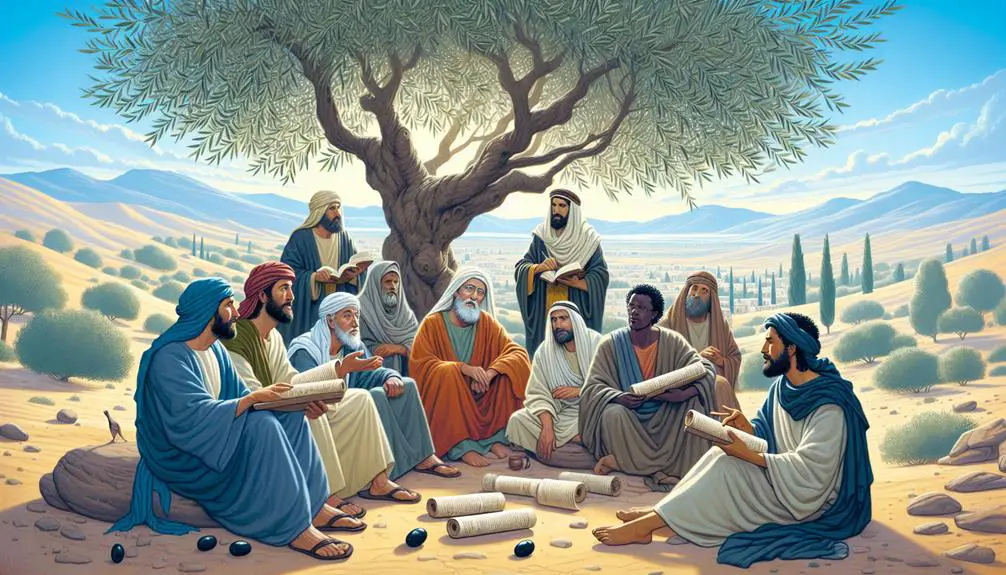
Are White People in the Bible
As you embark on this journey, consider the tapestry of humanity woven throughout the Bible's pages, rich in color and complexity. You're about to explore the landscapes of ancient times, where the concept of race and ethnicity might not align with modern interpretations.
The question of whether white people are mentioned in the Bible requires understanding the historical and geographical context of biblical stories. It's about digging into the roots of biblical characters and their ancestry, interpreting descriptions of skin color, and examining the role of culture and identity.
This exploration could challenge your perceptions and broaden your understanding of the Bible's relevance to all of humanity. Why does this matter to us today? Let's find out together.
Key Takeaways
- Biblical narratives feature a diverse tapestry of ethnicities shaped by their geographical and cultural contexts.
- Modern genetics and archaeological findings challenge simplistic racial categorizations of biblical characters.
- Cultural and societal norms of the time, rather than skin color, were primary identifiers in biblical stories.
- Interpretations of skin color in the Bible are influenced by historical contexts and symbolic meanings, not modern racial constructs.
Understanding Biblical Ethnicity
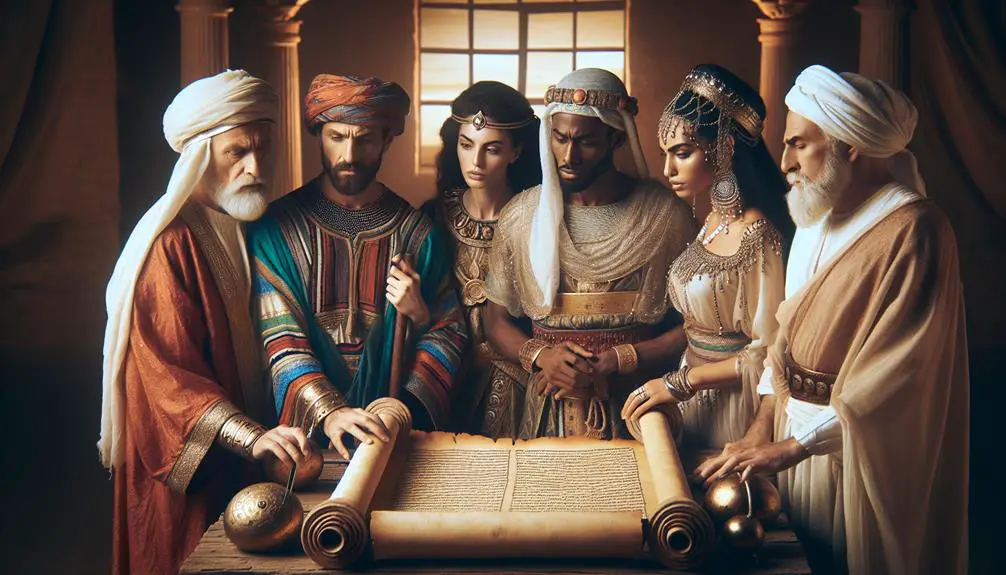
To understand biblical ethnicity, it's crucial to analyze the historical and cultural contexts in which the Bible was written. The Bible's narratives unfold across diverse regions and peoples, reflecting a tapestry of ancient ethnicities. Modern genetics has provided insights into the populations of the Near East and surrounding areas during biblical times, revealing a complex interplay of migration, conquest, and cultural exchange. These genetic findings challenge simplistic categorizations of biblical figures into contemporary racial groups.
The concept of race as understood today didn't exist in the biblical world. Instead, people were identified more by their tribal affiliations, language, and territory than by physical characteristics. Religious symbolism further complicates the understanding of ethnicity in the Bible. Symbolic representations of individuals or groups often transcended literal descriptions, serving theological purposes rather than providing historical or ethnographic accuracy.
Incorporating modern genetics into biblical scholarship offers a nuanced view of the ancient world's ethnic landscape. It underscores the fluidity of identity and the interconnectedness of various groups, challenging modern projections of race onto ancient peoples. This approach also illuminates the symbolic use of ethnicity in biblical texts, where the portrayal of different peoples can symbolize broader themes such as purity, sin, or divine favor.
Understanding biblical ethnicity requires a careful consideration of both the historical context and the religious symbolism within the texts. It's an exercise in reading ancient narratives through the lens of their own time, informed by the insights of modern genetics, rather than imposing contemporary notions of race onto the past.
The Geography of Ancient Times
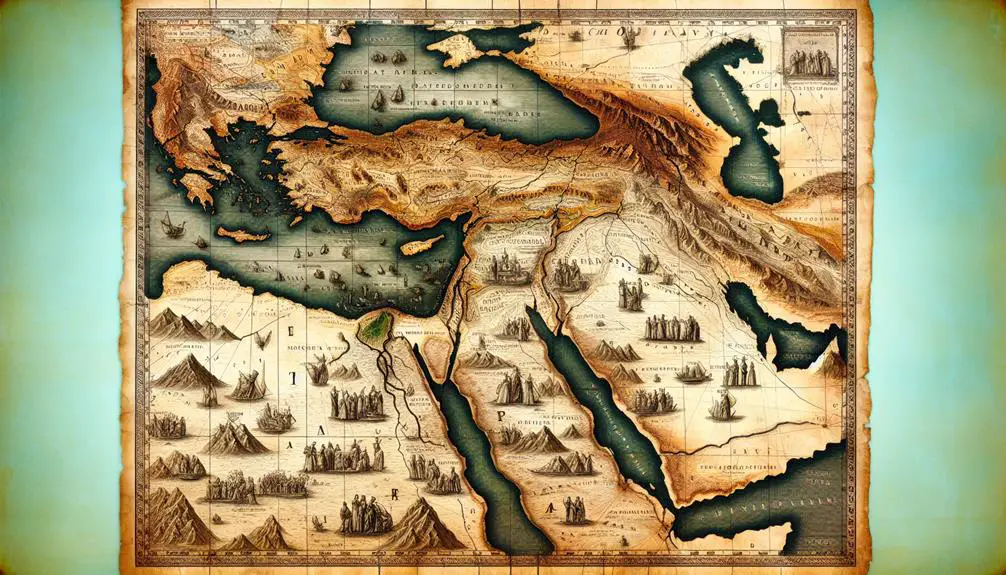
You must consider how the geography of ancient times shaped the interactions between different peoples and cultures.
The ancient lands overview provides a foundation for understanding the context in which these interactions occurred.
Analyzing cultural interactions offers insights into the complexities of historical ethnic relations and identities.
Ancient Lands Overview
Several ancient lands, pivotal in biblical narratives, span across what's now the Middle East and North Africa, each with distinct geographical and cultural landscapes.
Modern archaeology has unearthed evidence that these regions, once bustling with ancient civilizations, were deeply influenced by their climates. You'll find that the arid deserts, fertile river valleys, and strategic coastal areas shaped the development of societies, economies, and cultures in profound ways.
Climate influence wasn't just a backdrop but a dynamic force that directed the course of human history in these lands. This understanding helps to decode the complex interplay between environment and human activity, offering insights into the lives of the people who inhabited these ancient worlds and the stories that have been passed down through generations in biblical texts.
Cultural Interactions Explored
Understanding the geographical backdrop of ancient times enriches our comprehension of the cultural interactions that shaped the societies mentioned in biblical narratives. The terrain, climate, and natural resources of the Near East facilitated a mosaic of cultures and ethnicities, challenging modern projections and racial assumptions about ancient peoples.
- The crossroads of Africa, Asia, and Europe made the ancient Near East a melting pot of cultures and races.
- Trade routes facilitated not only the exchange of goods but also ideas, religions, and genetic diversity.
- Environmental factors, such as desert barriers and fertile river valleys, influenced migration patterns and settlements, further complicating simplistic racial categorizations.
Analyzing these elements helps us appreciate the complexity of ancient societies, moving beyond anachronistic views to a more nuanced understanding of their dynamic interactions.
Biblical Characters and Ancestry
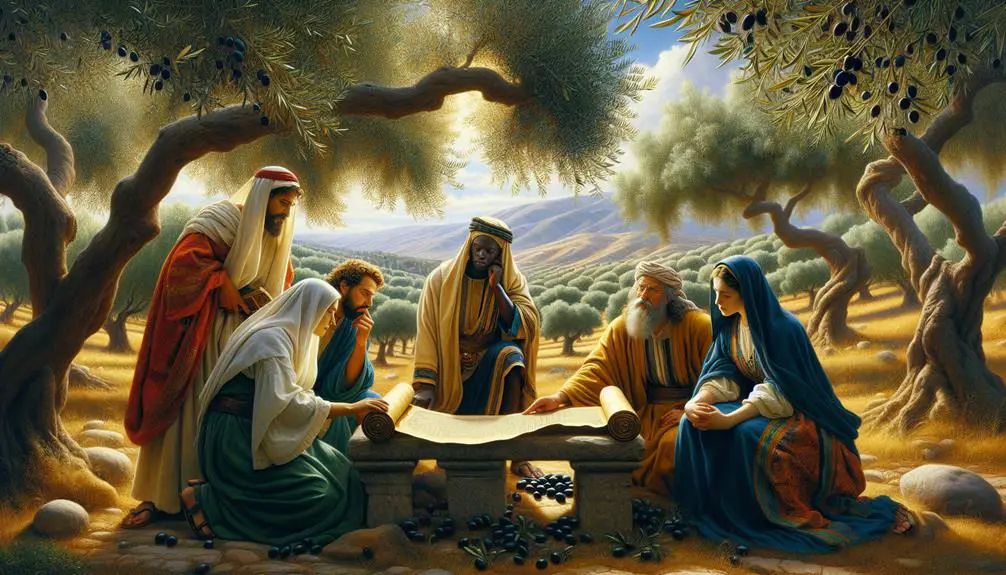
You'll explore the ethnic origins of biblical characters, tracing key figures' ancestral lines to understand their backgrounds.
By examining these lineages, you gain insights into the cultural contexts that shaped their lives and narratives.
This approach allows for a nuanced understanding of the diverse identities present in biblical stories.
Ethnic Origins Explored
Exploring the ethnic origins of Biblical characters offers insight into the diverse ancestries that shape the narratives within the scriptures. Advances in genetic studies and understanding language evolution provide tools for scholars to trace the ethnic backgrounds of these ancient figures.
- Genetic studies reveal connections between populations, shedding light on the migratory patterns that influenced the demographic landscape of the Biblical era.
- Language evolution tracks changes in dialects and scripts, offering clues about cultural assimilation and the spread of ideas.
- Archaeological findings support textual analysis, providing tangible evidence of the ethnicities that inhabited the Biblical regions.
Key Figures' Ancestral Lines
Tracing the ancestral lines of key biblical figures reveals a complex tapestry of identities and origins, shaping our understanding of their historical and spiritual contexts. Genetic research has begun to offer insights into these lines, suggesting a diversity that transcends simplistic racial categorizations.
Such studies underscore the interconnectedness of ancient populations, revealing that the ancestors of biblical characters might've shared genetic markers with contemporary Middle Eastern and Mediterranean peoples. This information draws modern parallels, highlighting how migration and intermarriage have always been integral to human history.
Cultural Contexts Considered
To fully appreciate the narratives of biblical characters, it's crucial to consider the cultural contexts from which they emerged, including their ancestry and the societal norms of their times. This approach helps dismantle racial assumptions and ensures a commitment to historical accuracy.
- Geographical origins: Understanding the geographical settings of biblical stories sheds light on the ethnic backgrounds of its characters.
- Societal norms and values: Analyzing the societal norms and values of the times provides insights into the behaviors and decisions of biblical figures.
- Linguistic and cultural diversity: Recognizing the diversity within the biblical world helps avoid oversimplification of characters' identities based on modern racial categories.
Interpretations of Skin Color

Understanding interpretations of skin color in the Bible requires a nuanced analysis of historical, cultural, and theological contexts. You'll find that biblical references to skin color often carry meanings that transcend literal descriptions, intertwining deeply with color symbolism and the nature of modern projection. Scholars suggest that ancient societies, including those depicted in biblical narratives, didn't categorize people based on skin color in the same way contemporary society does. Instead, color symbolism in these texts may reflect moral, spiritual, or status-related distinctions rather than an accurate portrayal of racial identities.
The Bible's descriptions of skin color and the emphasis placed upon it can be misleading when read through a modern lens. For instance, the mention of 'white' or 'light' skin in certain passages has been interpreted by some to signify purity or divine favor, while 'dark' skin has been controversially interpreted by others. However, you'll find these interpretations lack consistency and are often influenced by modern projection of racial constructs onto ancient texts. The original Hebrew and Greek texts employed a limited palette of color terms, and these were used with a range of meanings that don't align neatly with today's understanding of race or ethnicity.
Analyzing biblical references to skin color, therefore, demands a careful consideration of the text's original linguistic, cultural, and historical context. It's crucial to distinguish between the text's inherent meaning and the layers of interpretation added over centuries. By doing so, you can avoid the pitfalls of anachronistic readings and appreciate the rich tapestry of meanings that these ancient texts offer.
The Role of Culture and Identity

The cultural and identity landscapes depicted in the Bible significantly influence its characters' actions and societal norms, shaping the narrative in profound ways. Through stories and teachings, the Bible offers a lens into the ancient world, where culture and identity were pivotal in defining the community and individual roles within it. Identity formation and cultural symbolism play crucial roles in this ancient text, offering insights into how communities perceived themselves and others.
- Identity formation is central to the narratives, where lineage and tribal affiliations determine power, duty, and societal status. These elements underscore the importance of belonging and identity in the biblical world, highlighting how ancestral and tribal connections shape individual and collective identities.
- Cultural symbolism is richly woven into the fabric of biblical stories, with objects, rituals, and practices serving as symbols of covenant, faith, and communal identity. This symbolism not only adds depth to the narrative but also serves as a tool for transmitting cultural values and norms across generations.
- Cultural clashes and exchanges depicted in various stories illustrate the dynamic nature of identity and culture, showing how encounters between different groups lead to conflict, assimilation, or transformation. These interactions highlight the fluidity of identity and the impact of cultural exchange on societal development.
Implications for Modern Readers

Given the significant role of culture and identity in shaping biblical narratives, it's crucial for modern readers to reflect on how these elements influence their interpretation and application of the text. The question of whether white people are depicted in the Bible isn't merely a matter of curiosity but one that invites a deeper understanding of historical accuracy and racial sensitivity. By acknowledging the diverse ethnic backgrounds present in the biblical world, you're encouraged to approach the scriptures with an awareness that transcends modern racial constructs.
Racial sensitivity plays a pivotal role in this context. As a modern reader, you're tasked with recognizing the potential for anachronistic interpretations—projecting contemporary racial categories onto ancient peoples. This awareness is vital in fostering a more inclusive understanding of the Bible, one that respects the text's cultural and historical specificity.
Moreover, a commitment to historical accuracy demands a nuanced consideration of the Bible's cultural setting. The Middle Eastern and North African origins of biblical figures challenge the often Eurocentric portrayals seen in popular media. By engaging with the text through the lens of historical accuracy, you're better equipped to appreciate its richness and complexity.
Frequently Asked Questions
How Have Depictions of Biblical Characters in Art and Media Influenced Perceptions of Their Ethnicity?
Depictions of biblical characters in art and media, heavily shaped by Renaissance influence and cultural bias, have significantly impacted perceptions of their ethnicity.
You've likely noticed how these representations often feature characters with European features, deviating from their historical Middle Eastern origins.
This visual portrayal can skew your understanding, making it challenging to reconcile the characters' likely ethnicities with the predominantly white figures presented in many Western artistic and media interpretations.
What Are the Historical and Archaeological Evidences That Challenge Traditional Views of Race in Biblical Contexts?
Peeling back history's layers, you'll find historical and archaeological evidence challenging traditional views on race in biblical contexts. These findings highlight climatic adaptations and cultural symbolism, steering the narrative away from simplified racial categorizations.
How Do Linguistic Analyses of Original Biblical Texts Contribute to Our Understanding of Racial Diversity in the Bible?
You'll find that linguistic analyses of original biblical texts, focusing on semantic interpretation and textual variants, significantly enhance our understanding of racial diversity in the Bible.
By examining how words and phrases were used historically and culturally, scholars can uncover more nuanced views of race.
This approach helps to decode the complex layers of meaning in the texts, providing a clearer picture of the racial diversity that existed in biblical times.
In What Ways Have Modern Political and Social Movements Reinterpreted Racial Identities in the Bible?
Modern political and social movements have significantly reinterpreted racial identities in the Bible through the lenses of cultural assimilation and identity politics.
You'll find that activists and scholars alike delve into the text, analyzing how these identities have been molded or erased over time.
They argue that historical and contemporary contexts of power dynamics play a crucial role in these reinterpretations, highlighting the fluidity and complexity of racial identities within biblical narratives.
Can Genetic Studies Provide Insights Into the Racial Backgrounds of Biblical Populations?
Imagine unraveling the tightly coiled strands of DNA, each twist whispering ancient tales of human history. Genetic studies, through DNA sequencing, offer a revolutionary lens to peer into the racial backgrounds of biblical populations.
Conclusion
In conclusion, navigating the complex tapestry of biblical ethnicity is akin to unraveling a millennia-old scroll.
You've seen that the Bible's characters and their backgrounds are products of their diverse, ancient landscapes, transcending simple categorizations like 'white.'
Through scholarly analysis, you've understood that interpretations of skin color in the Bible are deeply entwined with culture and identity, challenging modern readers to reflect on the implications for contemporary discussions about race and belonging.

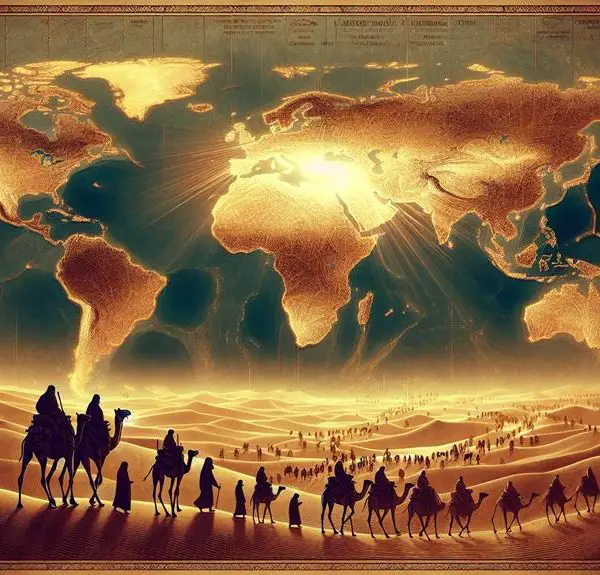
Sign up